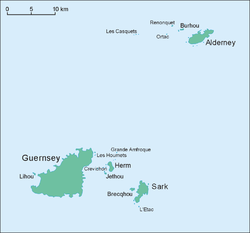
Back Guernsey ACE Guernsey Afrikaans ገርንዚ Amharic Guernési AN Guernsey ANG गुएनर्से ANP غيرنزي Arabic جيرنزى ARZ Guérnesei AST Gernsi Azerbaijani
Bailiwick of Guernsey | |
|---|---|
British Crown Dependency | |
| Anthem: Various: God Save the King and "Sarnia Cherie" | |
Location of Bailiwick of Guernsey (circled) in the English Channel (red) | |
 Map of the Bailiwick | |
| Sovereign state responsible for the Bailiwick[1][2] | United Kingdom |
| Separation from the Duchy of Normandy | 1204 |
| Largest settlement and administrative centre | St. Peter Port (St. Pierre Port) |
| Official languages | English |
| Recognised national languages | |
| Religion | Church of England |
| Government | |
| Charles III | |
| Richard Cripwell | |
• Bailiff | Sir Richard McMahon |
| Legislature | States of Guernsey |
| Area | |
• Total | 78 km2 (30 sq mi) (223rd) |
• Water (%) | 0 |
| Highest elevation | 374 ft (114 m) |
| Population | |
• 2016 estimate | 67,334[5] (206th) |
• Density | 844/km2 (2,185.9/sq mi) (14th) |
| GDP (PPP) | 2003 estimate |
• Total | $2.1 billion (176th) |
• Per capita | £33,123 (37th) |
| GDP (nominal) | estimate |
• Total | USD 4,513,630,000[6] |
| HDI (2008) | 0.975[7] very high · 9th |
| Currency | Pound sterling Guernsey pound (£) (GBP) |
| Time zone | UTC+00:00 (GMT) |
• Summer (DST) | UTC+01:00 (BST) |
| Date format | dd/mm/yyyy |
| Mains electricity | 230 V–50 Hz |
| Driving side | Left |
| Calling code | +44 |
| ISO 3166 code | GG |
| Internet TLD | .gg |
| Jurisdictions | Alderney Guernsey Sark |
The Bailiwick of Guernsey (French: Bailliage de Guernesey; Guernésiais: Bailliage dé Guernési) is a self-governing British Crown Dependency off the coast of Normandy, France, comprising several of the Channel Islands. It has a total land area of 78 square kilometres (30 sq mi) and an estimated total population of 67,334.
The Channel Islands were part of the Duchy of Normandy, whose dukes became kings of England from 1066. In 1204, as a consequence of the Treaty of Le Goulet, insular Normandy alone remained loyal to the English Crown, leading to a political split from the mainland. Around 1290, the Channel Islands' Governor, Otto de Grandson, split the archipelago into two bailiwicks, establishing those parts other than Jersey as a single Bailiwick of Guernsey.[8]: 21
The Bailiwick is a parliamentary constitutional monarchy, comprising three separate jurisdictions: Alderney, Guernsey (incorporating Herm), and Sark. The Lieutenant Governor is the representative of the British monarch, who remains the head of state. The States of Guernsey is the parliament and government of the whole Bailiwick, though several matters are decided locally by the States of Alderney and by Sark's Chief Pleas. The Bailiff of Guernsey is the civil head of the Bailiwick, and is also president of the States of Guernsey and head of the Bailiwick's judiciary.
The Bailiwick is self-governing and not part of the United Kingdom.[9][10] Its defence and international representation — as well as certain policy areas, such as nationality law — are the responsibility of the UK Government, but the Bailiwick still has a separate international identity.[11]
- ^ Fact sheet on the UK's relationship with the Crown Dependencies (PDF), UK Ministry of Justice, retrieved 2 May 2023,
The Crown Dependencies are not recognised internationally as sovereign States in their own right but as "territories for which the United Kingdom is responsible".
- ^ Framework for developing the international identity of Guernsey, States of Guernsey, retrieved 2 May 2023,
2. Guernsey has an international identity which is different from that of the UK.
- ^ The Queen: Elizabeth II and the Monarchy, p. 314, at Google Books
- ^ The Channel Islands, p. 11, at Google Books
- ^ "Guernsey - The World Factbook". www.cia.gov. 14 November 2022.
- ^ "About the Bailiwick of Guernsey". Channel Islands Brussels Office (CIBO). 15 September 2019. Retrieved 9 August 2021.
- ^ Filling Gaps in the Human Development Index Archived 2011-10-05 at the Wayback Machine, United Nations ESCAP, February 2009
- ^ Cite error: The named reference
TCIwas invoked but never defined (see the help page). - ^ Mut Bosque, Maria (May 2020). "The sovereignty of the British Crown Dependencies and the British Overseas Territories in the Brexit era". Island Studies Journal. 15 (1): 151–168. doi:10.24043/isj.114.
- ^ Committee, European Union (23 March 2017). Brexit: the British Crown Dependencies (PDF) (Report). House of Lords. Archived from the original (PDF) on 27 April 2021. Retrieved 6 May 2021. (Summary, first sentence; Paragraph 4)
- ^ Torrance, David (20 June 2022). The Crown Dependencies (PDF) (Report). House of Commons Research Library. Retrieved 16 November 2022.


